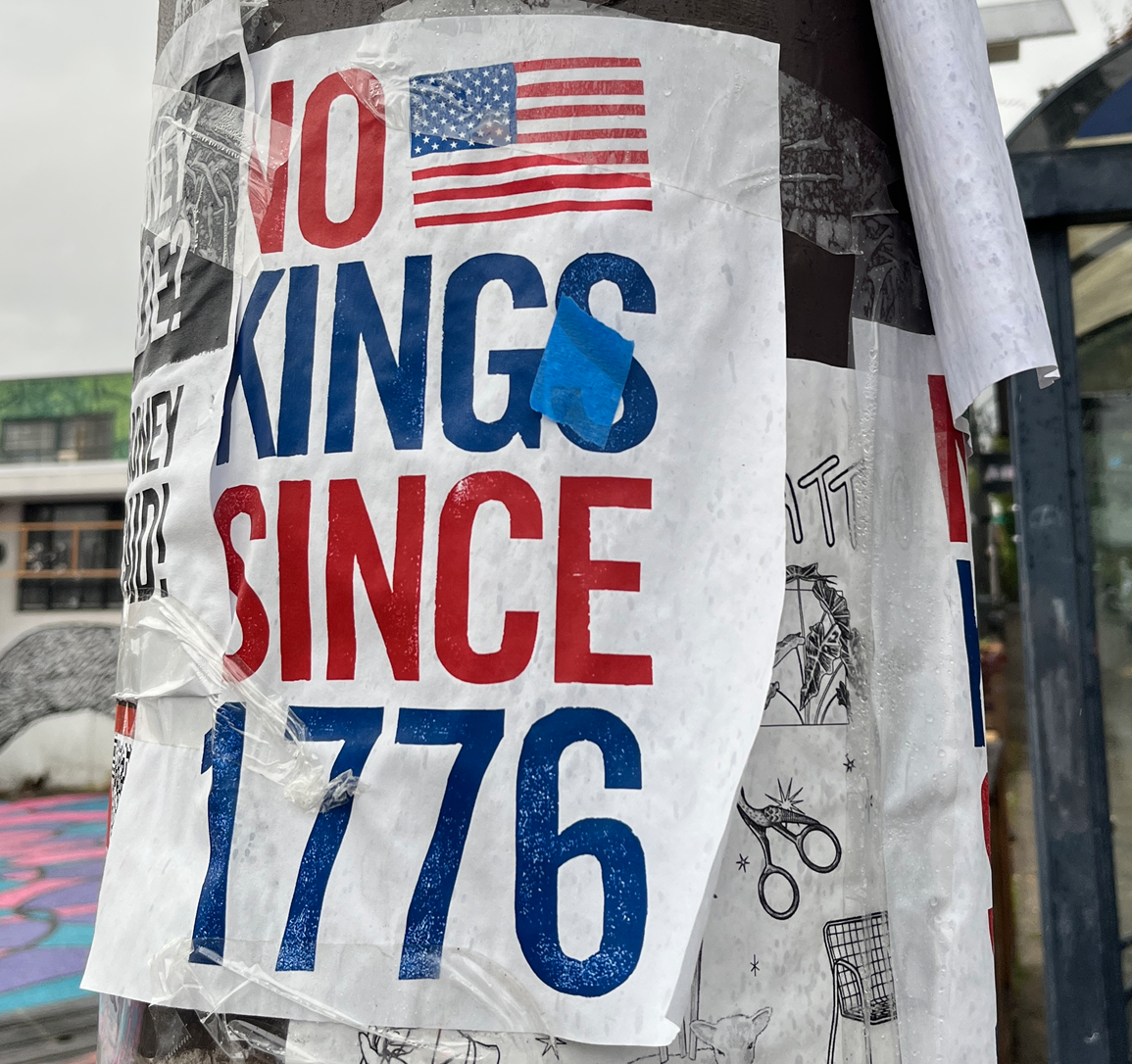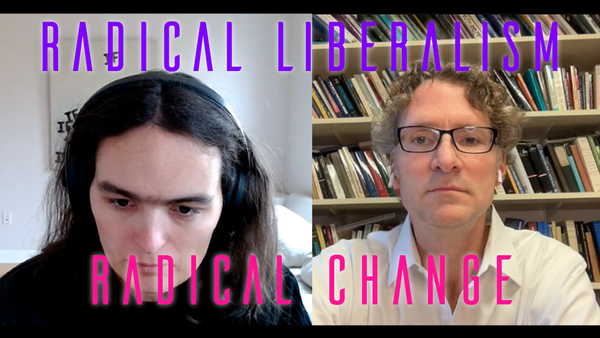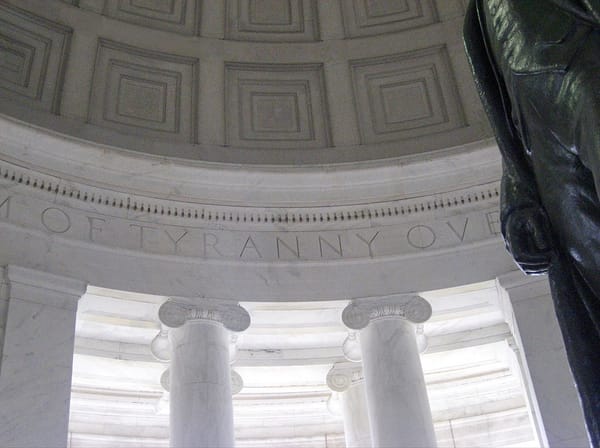Fight On Everything
"This dictatorship has been asserted but not yet consolidated. We must therefore 'fight on everything,'" according to Rob Tracinski's "Dictator From Day One."

Robert Tracinski's Dictator From Day One sets out its project on page one: to provide an "overview that is brief, readable, and extremely timely" of "American's political devolution from a free society to an authoritarian dictatorship."
Every day we are deluged with news of a new outrage from Trump II. He has lawlessly shuttered government departments, purged the Joint Chiefs of Staff of everyone who is not a white man, attempted further purges of trans servicemembers, unleashed a plague of masked thugs on our streets—on and on and on. You can drown in that deluge. Tracinski urges us to take a step back and get back to our philosophical roots—to "think like the Founders," and see Trump II not as a series of outrages but a single coherent picture. An attempt to destroy our system of limited, Constitutional government, and institute a personalist dictatorship in America.
Tracinski is in some ways an odd messenger for this radical message. He is a Senior Fellow at the Atlas Society, a nonprofit whose one-sentence pitch is "Our moonshot: Engage a billion young minds with the ideas of Ayn Rand." He himself is the author of The Free Market Futurist newsletter, contributes to ideological moderate outlets such as Persuasion, and holds a degree in philosophy from the University of Chicago (full disclosure: as do I). In other words, if you grew up as a progressive Democrat, as I did, Tracinski has the resume that would lead you to expect him to be on the other side of the political divide.
But Tracinski is right. We have exited normal politics. We are no longer here to have a debate about the importance of the top marginal tax rate. We are here to save our republic. Tracinski makes this case over five core chapters, "The Power of the Purse," "The Immigration Police State," "The Calvinball Courts," "'I Own The Store,'" and "The Emperor of Everything." Each of these chapters reviews a different aspect of Trump's power grab (13).
1. He has stolen from Congress the power to control government spending.
2. He has created a vast apparatus to seize and imprison people without due process.
3. He has defied the courts and schemed to curtail their power.
4. He has sought to control the economy with arbitrary powers to tax and regulate.
5. He has asserted control over independent institutions such as universities and the press.
Tracinski's core point is that we must see each of these not as an isolated policy initiative, to be weighed in terms of costs and benefits, but rather as an attack on the structure of our government (6). Take the last prong. Some academics have welcomed Trump's attacks on the academy. They have disputes with their colleagues or their administrations about the correct form of antidiscrimination policy. They welcome Trump's attacks on "DEI" because they want that policy changed.
Likewise, some China hawks have welcomed Trump's trade wars, believing that the United States has fallen behind on this or that critical industrial policy. But as Trump has made clear—and as Tracinski documents in this book—Trump's trade wars do not reflect a consistent, coherent industrial policy. They reflect a desire to centralize economic power in his hands personally. Trump's assaults on universities are not about this or that framework of antidiscrimination policy. They are about personal control over private institutions: "a system of one-man rule, in which all decision-making... is ultimately decided personally by him," (6).
The American system of limited government—the system that has guided our nation from a collection of squabbling revolutionaries to the greatest power in history—is built on the bedrock idea that it matters how decisions are made. Democratically, with checks and balances, and respect for certain inalienable rights. The alternative is dictatorship. And dictatorship is what Trump is attempting to institute.
This fact has been somewhat disguised from the American people, because Trump's assault on our republic has taken place with the complicity of Congress and the Supreme Court. The Republicans in Congress have simply declined to assert their control over the purse strings. Republicans on the Court, meanwhile, have issued a blizzard of "temporary" orders and rulings, staying lower court rulings that went against Trump.
For instance, one of Trump's first executive orders was to "rescind" the guarantee of the 14th Amendment that all persons born in the United States are citizens of the United States. A lower court promptly—and correctly—ruled that this was unconstitutional, and issued a nationwide injunction against its enforcement. The Republicans on the Court stayed that nationwide injunction, leaving the case to grind its way through the court system; indeed they chose this case specifically to end nationwide injunctions generally. At the same time, Roberts and his accomplices declined to actually rule in favor of Trump. In this way, like Republicans in Congress, they have systematically avoided direct confrontation with Trump's dictatorial assertions. They are kicking the can down the road.
This has prevented any single crisis from exploding into a direct confrontation between our branches of government. Trump de facto arrogates dictatorial power to himself, while his Republican accomplices enable the media to pretend that the Constitution is perfectly intact.
This is perhaps why Tracinski exhorts us to "think like the Founders." We cannot assume that our Constitution is intact simply because John Roberts assures us that it is. We must focus on the philosophical foundations of government and society. And we must do so in a public and popular way, not merely within the walls of the ivory tower. Unlike the nations of the Old World, constructed of class and tradition, America is a nation of ideas (9).
On the other hand, in some ways the book is light on "fundamental and universal" thinking (9). There is no review of the various strategies pursued by competitive authoritarians around the world today—from Hungary's Victor Orban to Turkey's Recep Erdoğan to Russia's Vladimir Putin or Singapore's People's Action Party. It might have been illuminating to compare strategies of consolidation pursued by successful dictators—and strategies of resistance pursued by insurgents, like the Civic Coalition's mixed results in Poland.
Dictator From Day One is simply not a careful academic analysis of the flavors of non-democratic politics, nor an attempt to fit the Trump regime in that structure. Is this a personalist dictatorship? A competitive authoritarianism? A kleptocracy or an autocracy? Actual fascism? These are simply not the questions Tracinski is after.
Instead, Tracinski focuses on the tactics of the here-and-now, immediate demands of both individual citizens and politicians who still believe in our Constitution. As he says, "This dictatorship has been asserted but not yet consolidated and entrenched," (12). We must therefore "fight on everything," (129). In many ways this is Tracinski's core demand: fight on everything.
He offers several arguments for this. First, we cannot sit back and wait for thermostatic public opinion (10) to deliver a win—Trump is aggressively moving to rig and contest the election (123). We must "[block] as much of Trump's agenda as possible now" (128)—as Adam Gurri argued in these pages, days after Trump's electoral victory. Indeed, Tracinski argues that we should shut down the government whenever possible (128), in order to highlight that Trump has seized the power of the purse.
According to Tracinski, this relentless assault promises several benefits. First, fighting helps to shift the terms of public debate and mobilizes supporters. Caving in and throwing marginalized groups—such as trans people—under the bus simply legitimates the right's narrative (133). More, fighting consumes resources from the other side (130). Perhaps most importantly, "you find out what works and who fights" (132). Fighting is itself an information-gathering exercise. Fighting enables us to identify our peacetime generals and replace them with genuinely effective leaders (126).
And yet. I am hesitant to endorse "fight on everything" simpliciter. Picking bad fights can hurt you, can enable the other side to advance their goals. Perhaps even more importantly, how you fight matters. The first government shutdown fight, a carefully stage-managed bit of kabuki theater, demoralized Democrats and handed Trump a win. The second shutdown fight has been far more effective, at least in part because of improvements in Democratic messaging and narrative coherence: they have successfully branded it as a Trump shutdown and an assault on health care.
As I have argued in these pages, it's not enough to have a mass movement that takes to the streets and brings the fight to the enemy. All of us have seen such movements explode and then flame out in our lifetimes. Success against Trump will require genuine tactical acumen and strategic clarity.
Consider the iconic image of the Portland frog facing off against ICE's masked thugs. That moment—much like the emergency naked bike ride, or Kristi Noem facing off with a guy in a chicken suit—was calculated to both oppose ICE's lawless kidnappings, and to deflate the reactionary narrative of cities under siege by antifa vigilantes. This was not inevitable, but rather reflects a tactical choice. "Just fight" is not good advice if it is taken to imply maximalist aggression in every case. Firebombing a Walmart is not what we need today.
The lesson is of general application. The generals Tracinski admires—Grant and Sherman foremost among them—were not mindless butchers, ordering direct assaults on every occasion. They married the absolute will to destroy the enemy with a calm, clear intellect that saw them through the dark forest of war—what I have called a war mindset. Success against Trump's power grab will likewise require a fiery heart and a cold head.
But those fiery hearts matter. It is no accident that Tracinski—like many others—is no longer reaching for the aesthetics of moderation and compromise, but the long tradition of militant liberalism. He evokes the Founders, revolutionaries against the British Empire, and the Wide Awakes, revolutionaries against the slave power. Notably, these are not the aesthetics of the radical left, the black bloc and the red flag flying. Rather, they have a closer kinship with the Tea Party of 2008. The No Kings protests, which put five million people into the streets in June, seven million this October, and who knows how many more in the years ahead, likewise are harking back to the elemental demand of the American Revolution: there are no kings in America.
The martial rhetoric is a sign of things to come. Amos Adams Lawrence, after witnessing the kidnapping of Anthony Burns in Boston by Southern slave-takers, said "We went to bed one night old fashioned, conservative, Compromise Union Whigs & waked up stark mad Abolitionists." As Trump's masked thugs patrol our streets—as Trump's billionaire cronies ransack our government—as Trump rips down the White House and lines his own pockets—more Americans are waking up, as Lawrence once did, to the fact that we have exited normal politics. Tracinski writes, "I hope, in this case, that we will not have to fight the kind of literal, physical conflict those young men [the first Wide Awakes] ended up fighting," (2).
So do I.
Featured image is [Untitled], CC-BY-SA Another Believer 2025.





